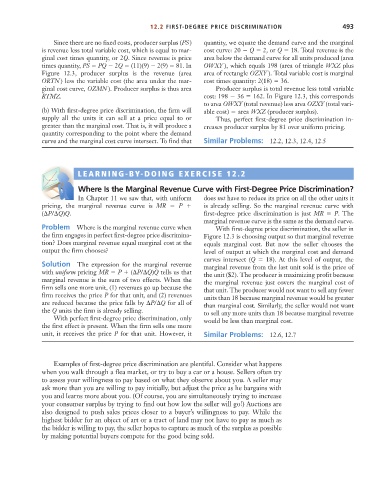Page 519 - Microeconomics, Fourth Edition
P. 519
c12capturingsurplus.qxd 7/22/10 10:41 AM Page 493
12.2 FIRST-DEGREE PRICE DISCRIMINATION 493
Since there are no fixed costs, producer surplus (PS) quantity, we equate the demand curve and the marginal
is revenue less total variable cost, which is equal to mar- cost curve: 20 Q 2, or Q 18. Total revenue is the
ginal cost times quantity, or 2Q. Since revenue is price area below the demand curve for all units produced (area
times quantity, PS PQ 2Q (11)(9) 2(9) 81. In OWXY ), which equals 198 (area of triangle WXZ plus
Figure 12.3, producer surplus is the revenue (area area of rectangle OZXY ). Total variable cost is marginal
ORTN ) less the variable cost (the area under the mar- cost times quantity: 2(18) 36.
ginal cost curve, OZMN ). Producer surplus is thus area Producer surplus is total revenue less total variable
RTMZ. cost: 198 36 162. In Figure 12.3, this corresponds
to area OWXY (total revenue) less area OZXY (total vari-
(b) With first-degree price discrimination, the firm will able cost) area WXZ (producer surplus).
supply all the units it can sell at a price equal to or Thus, perfect first-degree price discrimination in-
greater than the marginal cost. That is, it will produce a creases producer surplus by 81 over uniform pricing.
quantity corresponding to the point where the demand
curve and the marginal cost curve intersect. To find that Similar Problems: 12.2, 12.3, 12.4, 12.5
LEARNING-BY-DOING EXERCISE 12.2
S
D
E
Where Is the Marginal Revenue Curve with First-Degree Price Discrimination?
In Chapter 11 we saw that, with uniform does not have to reduce its price on all the other units it
pricing, the marginal revenue curve is MR P is already selling. So the marginal revenue curve with
( P/ Q)Q. first-degree price discrimination is just MR P. The
marginal revenue curve is the same as the demand curve.
Problem Where is the marginal revenue curve when With first-degree price discrimination, the seller in
the firm engages in perfect first-degree price discrimina- Figure 12.3 is choosing output so that marginal revenue
tion? Does marginal revenue equal marginal cost at the equals marginal cost. But now the seller chooses the
output the firm chooses? level of output at which the marginal cost and demand
curves intersect (Q 18). At this level of output, the
Solution The expression for the marginal revenue marginal revenue from the last unit sold is the price of
with uniform pricing MR P ( P/ Q)Q tells us that the unit ($2). The producer is maximizing profit because
marginal revenue is the sum of two effects. When the the marginal revenue just covers the marginal cost of
firm sells one more unit, (1) revenues go up because the that unit. The producer would not want to sell any fewer
firm receives the price P for that unit, and (2) revenues units than 18 because marginal revenue would be greater
are reduced because the price falls by P/ Q for all of than marginal cost. Similarly, the seller would not want
the Q units the firm is already selling. to sell any more units than 18 because marginal revenue
With perfect first-degree price discrimination, only would be less than marginal cost.
the first effect is present. When the firm sells one more
unit, it receives the price P for that unit. However, it Similar Problems: 12.6, 12.7
Examples of first-degree price discrimination are plentiful. Consider what happens
when you walk through a flea market, or try to buy a car or a house. Sellers often try
to assess your willingness to pay based on what they observe about you. A seller may
ask more than you are willing to pay initially, but adjust the price as he bargains with
you and learns more about you. (Of course, you are simultaneously trying to increase
your consumer surplus by trying to find out how low the seller will go!) Auctions are
also designed to push sales prices closer to a buyer’s willingness to pay. While the
highest bidder for an object of art or a tract of land may not have to pay as much as
the bidder is willing to pay, the seller hopes to capture as much of the surplus as possible
by making potential buyers compete for the good being sold.

